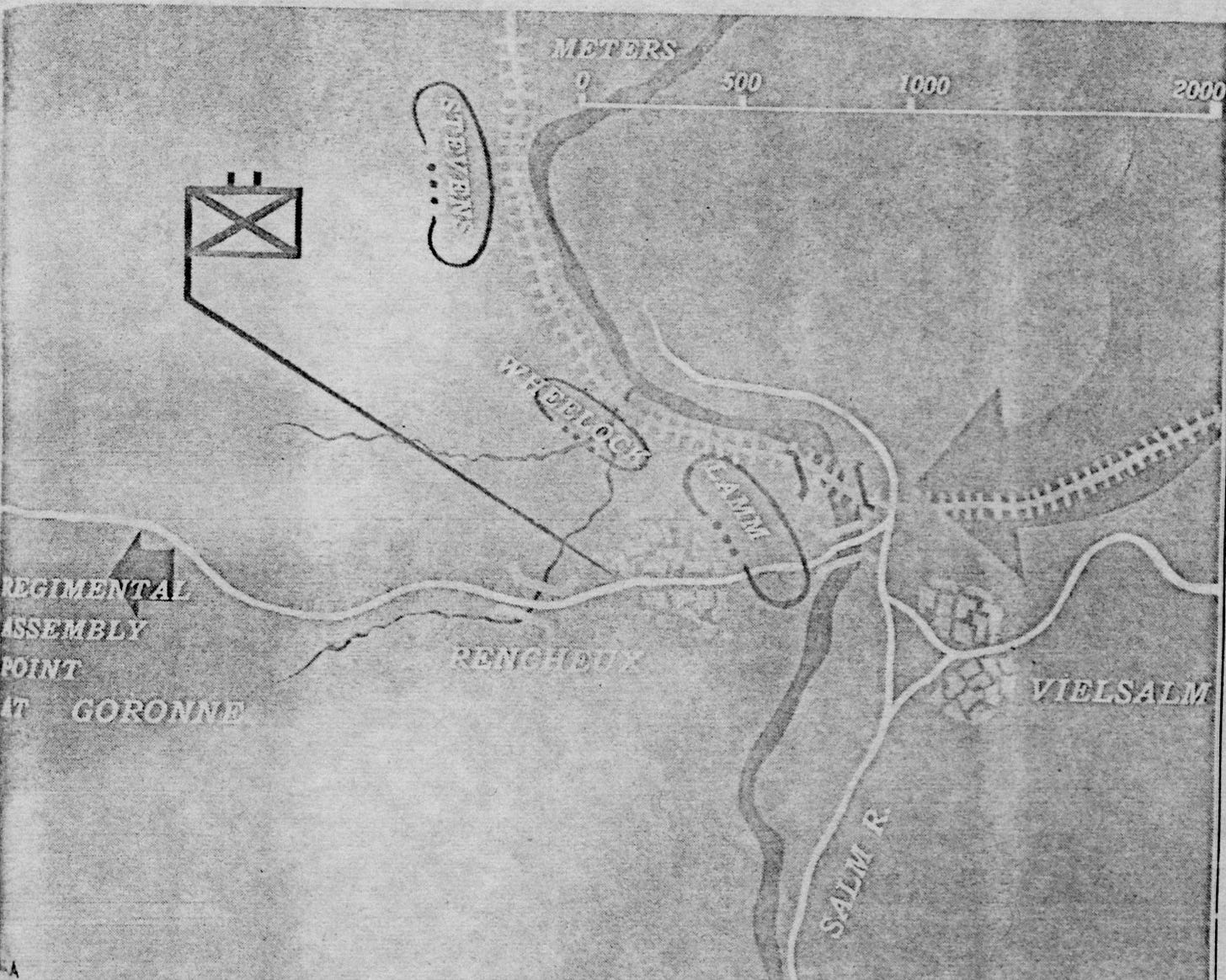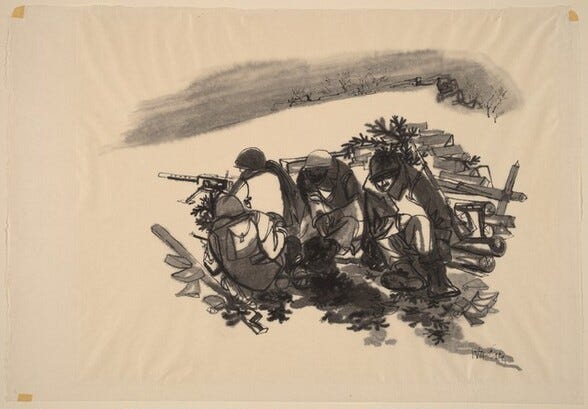Welcome to “Reinforced Winter,” where you can participate in the dissection of the 82nd Airborne’s actions in the Battle of the Bulge. This particular post is a continuation from the last edition which can be viewed by clicking here.

Without further ado, we continue Major Medusky’s essay
In the abandoned house which serves as Lamm’s CP, men fondle a treasured bottle of champagne, long saved for the stroke of 12 on Christmas Eve. It is not destined to be emptied.
At 2430, all hell hits Rencheux: artillery, mortars, machine guns and direct tank fire. The old houses rock to the jar of the explosions. Simultaneously, the center squad reports a smoke screen drifting across the river. Lt Lamm knows that this is it – a coordinated attack with artillery, engineers, smoke troops, infantry and armor – and attack in strength.
Lamm has twenty-four men, one 60mm mortar, two LMGs, two BAR’s, (one of his LMGs has been knocked out during the day by German tanks.) Now the tanks are lined up on the opposite bank, blasting straight into his positions, and the German infantry pushes across the wreckage of the railroad bridge.
Lamm’s platoon mans its guns, firing into solid masses of the enemy swarming over the bridge and up from the river and the smoke. But there are just too many, coming too fast.
Lt. Lamm sizes up the attack and sends a runner to Delameter. But as the lieutenant steps from his CP, a stream of Schmeisser bullets tears into the door. The Germans have overrun his position. In the uncertain glare, Lamm sees a man behind him. “Are the Germans back there, Sergeant Boone?”
The sergeants answers with a burst of machine pistol fire. He misses, but Lamm does not… He sends his assistant, Lt. Gyami, back to battalion with a runner and goes himself to check Sgt. Prestos’ squad to the right.
Sgt. Prestos has led a squad through two campaigns. He knows that “when you got a good leader, you got a good platoon; and when you got a good platoon, there isn’t much you can’t do.” But even a good platoon can’t hold back a battalion. Sgt. Prestos can handle enemy to his front, but MG 42’s are raking his right flank. Lamm tells him to hold as long as possible, then pull in slowly toward the center. He races off to check Sgt. Boone on the left.
He finds the sergeant behind his BAR, tearing into two long files of Germans moving straight up the road from the bridge. Flares cast a Christmas glow upon the snow, and tracers flash off the brick houses of Rencheux. The Germans come on until Boone’s men can toss grenades between their files – and still they come. The squad is overrun.
Lt. Lamm calls out for Boone. The sergeant comes running through the enemy with three of his six men. They start back, fighting off the Germans behind them, fighting through Germans in the front.
Blacking their path to the battalion assembly points lies Rencheux, now wholly in enemy hand. They cannot bull through. Sgt. Prestos has already pulled back, 30 to 50 yards at a time, moving around past the village and down the road leading west. With the other two squads and his CP group, Lt. Lamm sets off to the hills on the right and the regimental assembly point at Goronne.
Lt. Wheelock of B Company is new in the regiment, even newer as a platoon leader. In fact he took over the 3d Platoon at 1600 – a little more than nine hours ago. And at 2300, his assistant platoon leader was killed by an enemy patrol he was trying to ambush.
When the first enemy fire burst upon Rencheux, Lt. Wheelock was moving his CP to his center squad position. The German artillery caught the little group in the open. Wheelock never saw the others again. Leaning into the barrage, the enemy infantry charged up the hillside, and the fire fight was on.
The LMG’s and BAR’s of the left and center squads ripped at the Germans as long as they kept coming. After a while, no more came. But now the Germans who have overrun A Company are hitting the flank of the right squad. The squad leader, his face torn open by a bullet, is carried off by Private Packlewitz. Packlewitz goes back to his BAR, only to return to the platoon CP with news the Germans are already in the right squad’s foxholes. And on his heels comes Delameter’s runner with order to withdraw.
Lt. Wheelock leads his platoon down a draw to cover. The wounded squad leader is with him; his other squads are in-tact. But the CP group and the 60mm mortar squad are missing. Lt. Wheelock goes back to look for them. He finds the platoon position swarming with Germans. There is nothing to do but head back to his platoon, back towards the battalion assembly area and Goronne. The men of C Company have been lucky. They caught the artillery fire but were never attacked. When the order comes to withdraw, Lt Stevens and Lt. Kampe are able to bring back their whole platoon with only one man slightly wounded. Looking down on the battalion assembly point, they see the blaze of German tracers. Doggedly they set off cross-country for Goronne. But where is Delameter?
By 0115 Delameter has received orders to withdraw. He sends out the platoon runners and leads his own CP group to the assembly point in a valley to his rear. Now he has only to wait.
To his front all is confusion — shouts and firing, moonlight, tracers, flares. He dispatches men to search the hillsides right and left for the platoons. He himself steps out onto the road.
“Baker Company, assemble here! Able Company, assemble here!”
Shouts from the Germans are his only answer. The CP group fires at the voices. Suddenly the ground around them shakes with an artillery concentration planned to catch the advancing enemy. It is nearing 0200, and still Delameter waits.
Soon the CP group can see Germans moving against the snow and hear them chattering and calling to one another. Delameter counts three signal lights — apparently assembly points — a few hundred yards from him. Voices with heavy German accents imitate his call: “Baker Company, assemble here! Baker Company, assemble here!”
Nevertheless, some members of A Company succeed in reaching Delameter and are sent to the regimental assembly point. Next come Lt. Wheelock and the B Company platoon. Finally, about 0230, Delameter and his CP group start down the road to Goronne. Soon after he rejoins the regiment, Lt Lamm arrives with the remainder of his platoon.
Lamm has been delayed. He was already well on his way when he heard behind him the unmistakeable chatter of an American LMG. Roulette and DeMario - his machine gunners, and new men both - must still be in position! Buried by a shell burst early in the fight, they had dug themselves out and put their gun back in action. And now they were carrying on their own private battle after everyone else had quit.
Lamm had disengaged. He knew that he could lead his men safely to Garonne. But he could not leave the machine gun crew behind. And so he went back toward Rencheux and shouted for his missing men through the German fire.
The US .30 stopped. Out of darkness, the two soldiers plodded toward Lt. Lamb, carrying their equipment - gun and tripod and two boxes of ammunition. The gun jacket was scarred and dented by shell fragments; the men were covered with dirt: but Privates Roulette and DeMario were ready for anything their platoon leader might suggest.
“Hello, sir — what we gonna do now?”
Lamm laughed. “We’re withdrawing, of course!”
“Oh,” they repeated, “we’re gonna withdraw” — and fell into step behind him…
The fight which Delameter’s three platoons put up against a battalion plus coordinated attack completely fooled the Germans. They did not realize the Americans had withdrawn. They believed they had engaged the main American force and pushed it back several hundred yards. Early Christmas morning, the men of the 82d Airborne, digging in on their new line, heard the clamor of a mass attack — on nothing.
It took the Germans more than a day to feel their way across the seven mile vacuum. For three days, the enemy attacked the new line - and fell back. Then, with the new year, the division took the offensive. The 82d was on its way to Germany. It did not turn back again.
The story seems almost unbelievable. But it is not difficult to isolate causes of the covering force’s extraordinary success.
The first is leadership. The leaders were determined to accomplish their mission, and were able to instill their determination in every man who fought with them.
The second is confidence. A lesser man than Delameter or Lamb would have wavered in the crisis. One case of panic - one man breaking and running - might have collapsed the whole defense. But though these platoons should have been licked a dozen times, they didn’t know it.
The third is planning. The planning was rapid but not hasty. Every man knew what he was expected to do and why he was doing it. With so mall a force, a poor choice of positions would have left many holes for infiltration. But three platoons had been skillfully placed to cover the avenues of approach.
The fourth is training. This battalion - this regiment - this division had never before in their history made a combat withdrawal. They never made another. But in training, they performed withdrawals again and again… The investment paid dividends just once - the Christmas Eve of 1944. But for the men of the 82d Airborne Division, it was time well spent. After all, if you get killed once, you’re awful dead.
This essay, by Major John Medusky, was originally published in the April 1955 edition of Infantry School Quarterly, and is reproduced therefrom.
Check out other installments of “Reinforced Winter” you may have missed!











Absolutely thrilling. Such bravery is difficult to comprehend. Thanks for sharing.